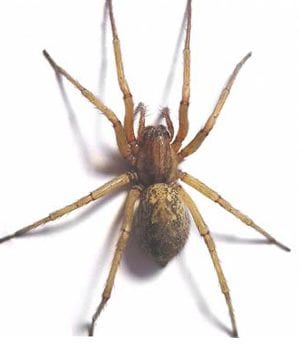How to tell if it’s a Hobo Spider or a Giant House Spider
Identifying whether you’re seeing an “Eratigena atrica,” (Giant House Spider) or a “Tegenaria Agrestis,” (A.K.A. “aggressive house spider” or hobo spider) is very difficult. Most scientists will insist that the only way to tell the spiders apart is to examine the actual spider, not a photo. But we think there are a few ways an amateur can spot one.
This is what a Giant House Spider looks like:


This is what a Hobo Spider looks like:


As you can see, they look very similar. If you have a high resolution camera, and can get close enough without disturbing the spiders, it is much easier to tell the difference than simply using the naked eye.
There are thee key differences to look for:
Even with a great photo, it can still be very difficult to compare the palps and genitals of the spider, so we recommend looking at the leg bands. That is the easiest way to identify if it’s a hobo spider or not.


A Giant House Spider has dark bands of color separating its leg joints. A Hobo Spider’s legs do not have leg bands. So, if you see leg bands, it’s likely not a Hobo Spider.
When you see either one of them in your house, it’s probably because they’ve left their web (we call it a “bone yard”) looking for a mate. Mating season spans the last few months of the year, peaking in November.
They prefer to make webs in a corner where it’s dusty, a signal that their habitat will remain undisturbed. But they also tend to live anywhere they can hide. Woodpiles, old boxes, fireplace masonry, cracks in wood or concrete — these are all excellent choices for a giant house spider or hobo spider to build a nest.
Their webs are not very large, so you’ll rarely see strands of silky spider web spun in intricate patterns up high. They are more like cobwebs that look like a sheet of thin, white cloth on the floor in the corner. Sometimes a funnel can be seen where the spider will hide. They’ll remain in their web during the day, becoming active at night. They’ll wait for an unsuspecting insect to walk by the web, where their speed is quite useful in catching its prey.
They range in color from light to dark brown. Markings on the back look like a blotchy stripe pattern, sometimes like a “chevron.” The females tend to be a bit larger, and a darker shade of brown than the males. Sometimes they appear black.
They are poor climbers, but they still try to climb sometimes. Usually, they’ll stay on the floor. Many people find them in the bathtub or the sink, not because they crawled up through the drain, but because they stumbled into the tub and were unable to climb out.
Don’t miss:

